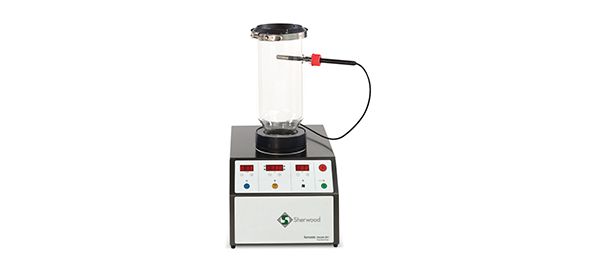Model 501 Fluid Bed Dryer

Model 501 Fluid Bed Dryer
Product Overview
what is fluid bed drying?
By forcing enough air through a bed of particles, the particle bed may assume a fluid-like state (resembling a boiling liquid). Heating the incoming air and managing air flow rate through the sample, a Fluid Bed Dryer provides thorough mixing and maximum contact of solid with moving air.
fast
Delivering up to 2.5m3 per minute of air, the Model 501 Fluid Bed Dryer can break up wet samples and ensure vigorous mixing and rapid moisture removal. 5kg of wet “ideal” sample (80% moisture) can be dried in 15-20 minutes (5 Litre tub).
mild
High air flow rate gives:
- High moisture removal rates at relatively low temperatures
- Thorough mixing, so no wet spots requiring extra thermal energy to penetrate
- An air cushion between particles to reduce abrasion and particle size alteration
non-agglomerating
Air separated particles prevents lumps and caking, both of which make other drying processes much slower.
homogeneity of sample
Static drying methods leave evaporation residues at the sample surface giving a heterogeneous sample. Fluid Bed Drying achieves the opposite. Mixing during Fluid Bed Drying gives homogeneous samples, making an ideal method of representative sample preparation for subsequent material analyses.
reproducible
Microprocessor control of air flow, inlet air temperature and drying period coupled with fluid bed action gives highly reproducible experiments and finished samples. After preliminary experiments, a known moisture content in the final sample (ideal for tablet forming) or removal of external (surface) moisture only, may be achieved. Drying times to required moisture content may be optimised and drying patterns studied to aid scale-up and plant design.
Without a PC connected the Model 501 Fluid Bed Dryer can run one stored program of up to 16 steps (previously downloaded from a PC), or may be used as a conventional (manually controlled) Fluid Bed Dryer. Additional features of this advanced in-lab dryer technology include:
- Precise air flow feed-back control
- Membrane sealed controls to prevent ingress of particles into the instrument
- Reduced operating noise
Advantages of the Model 501 Fluid Bed Dryer
The Model 501 Fluid Bed Dryer offers significant advantages over conventional drying techniques
- The high rates of heat and mass transfer ensure much faster and more homogeneous drying than other methods, e.g. oven and vacuum drying
- Drying times range from a few seconds to minutes. Complete drying is usually achieved in under 15 minutes; the exact time for a given sample, airflow rate and temperature setting, being very repeatable. A uniform, reproducible moisture content may also be achieved with experience*
- Materials with moisture contents from a few per cent to over 80 per cent may be dried
- The inlet air temperature range of ambient (+15°C) to 200°C covers most drying operations. Due to good mixing, the sample temperature is uniform and under close control during drying; advantageous for drying heat sensitive materials
The high performance characteristics of this instrument allow it to be used for many applications in addition to drying, such as:
- Quick determination of moisture content (e.g. coal, tobacco, food products) by correlation with weight loss over 5 mins, using specified drying conditions
- Mixing and blending of solids
- Rough classification of particle size (i.e. Stokes Law)
Among the wide range of materials that can be processed are pharmaceuticals, chemicals, minerals, foods, coals, wood chips, plastics, resins etc.
Why choose the Model 501 Fluid Bed Dryer?
The Model 501 can be considered as three Dryers in one:
Standalone Fluid Bed Dryer
The base unit and specified tub assembly for standalone operation.
Microprocessor control of air flow, inlet air temperature and drying period; coupled with fluid bed action gives highly reproducible experiments and finished material samples.
The Model 501 Fluid Bed Dryer is the latest model from Sherwood and has membrane sealed controls to prevent particle ingress and reduced operating noise.
Programmable Fluid Bed Dryer
Dryer base with specified tub assembly, connected to a pc hosting sherwood’s fluid bed dryer software programme.
The software allows control of all variable functions, data monitoring, feedback and creation of multi-step drying protocols designed to dry samples in the most efficient manner. The Model 501 Fluid Bed Dryer can be programmed (via the computer interface) to step through up to 16 drying steps with the following parameters defined and controlled: timer, blower motor speed and inlet air temperature. An optional pulse flow module can also be controlled using the software package. These variable parameters may be monitored and recorded throughout the drying programme. Each programme step may be terminated manually or when a pre-set time or condition (outlet temperature or relative humidity) has been achieved; whichever conditions occurs first.
Analytical Fluid Bed Dryer
The base unit and specified analytical tub assembly (fitted with auxiliary combined temperature and relative humidity probe) connected to a pc hosting sherwood scientific ltd’s fluid bed dryer software programme.
The ability to monitor in tub (above sample) “outlet” temperature and relative humidity allows for capture of additional data which may be used to understand better the drying behaviour of a material. The ability to transfer that data for post-run processing expands the scope for material drying behaviour studies, for example, material drying curve generation is possible.